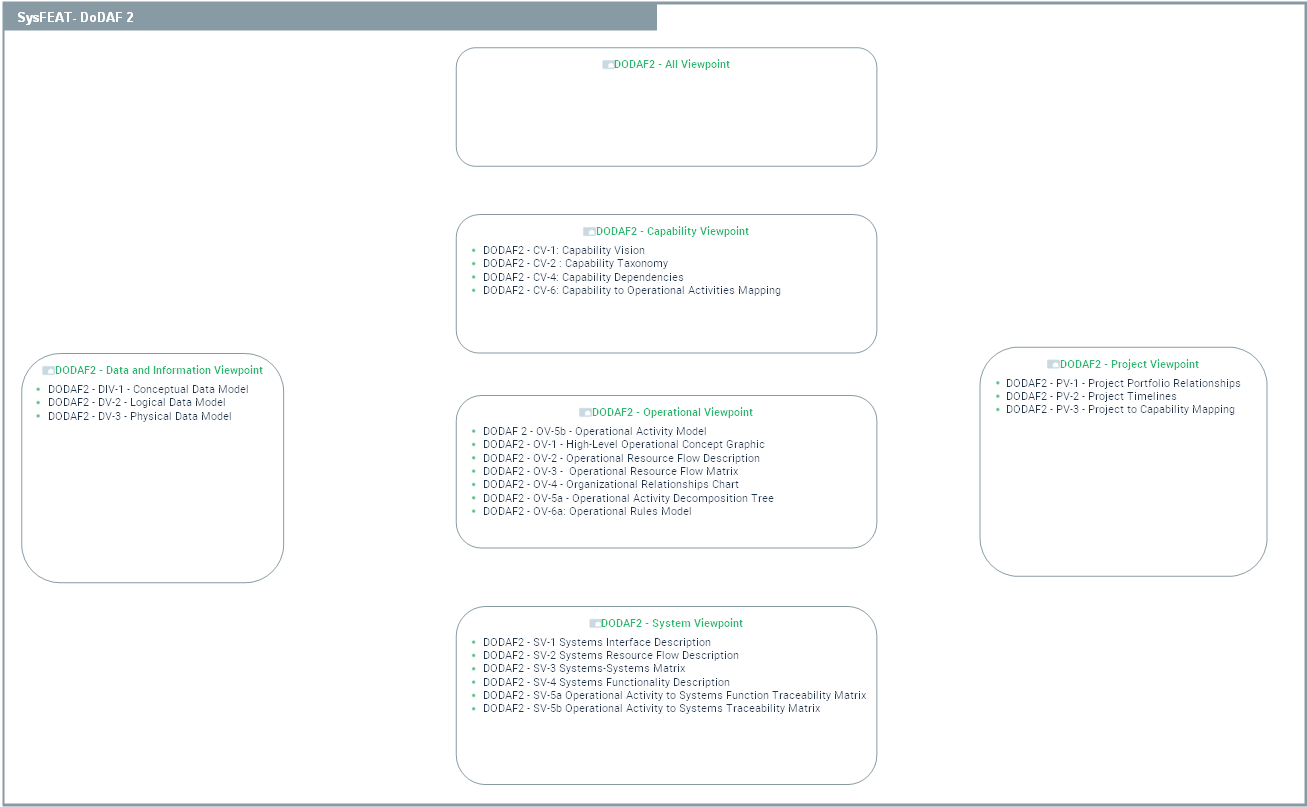| Name | Description |
|---|
 DODAF2 - Operational Viewpoint
DODAF2 - Operational Viewpoint |
DoDAF-described Models in the Operational Viewpoint describe the tasks and activities, operational elements, and resource flow exchanges required to conduct operations. A pure operational model is materiel independent. However, operations and their relationships may be influenced by new technologies, such as collaboration technology, where process improvements are in practice before policy can reflect the new procedures. There may be some cases, as well, in which it is necessary to document the way activities are performed, given the restrictions of current systems, to examine ways in which new systems could facilitate streamlining the activities. In such cases, operational models may have materiel constraints and requirements that need to be addressed. For this reason, it may be necessary to include some high-level system architectural data to augment information onto the operational models. |
 DODAF2 - All Viewpoint
DODAF2 - All Viewpoint |
The AV DoDAF-described Models provide information pertinent to the entire Architectural Description rather than representing a distinct viewpoint. AV DoDAF-described Models provide an overview of the architecturectural effort including such things as the scope, context, rules, constraints, assumptions, and the derived vocabulary that pertains to the Architectural Description. It captures the intent of the Architectural Description to help ensure its continuity in the face of leadership, organizational, and other changes that can occur over a long development effort. |
 DODAF2 - Capability Viewpoint
DODAF2 - Capability Viewpoint |
The Capability Viewpoint and the DoDAF-described Models within the viewpoint are introduced into DoDAF V2.0 to address the concerns of Capability Portfolio Managers. In particular, the Capability Models describe capability taxonomy and capability evolution. |
 DODAF2 - System Viewpoint
DODAF2 - System Viewpoint |
he DoDAF-described Models within the Systems Viewpoint describes systems and interconnections providing for, or supporting, DoD functions. DoD functions include both warfighting and business functions. The Systems Models associate systems resources to the operational and capability requirements. These systems resources support the operational activities and facilitate the exchange of information. The Systems DoDAF-described Models are available for support of legacy systems. |
 DODAF2 - Data and Information Viewpoint
DODAF2 - Data and Information Viewpoint |
DoDAF-described Models within the Data and Information Viewpoint provide a means of portraying the operational and business information requirements and rules that are managed within and used as constraints on the organizations business activities. |
 DODAF2 - Project Viewpoint
DODAF2 - Project Viewpoint |
The DoDAF-described Models within the Project Viewpoint describe how programs, projects, portfolios, or initiatives deliver capabilities, the organizations contributing to them, and dependencies between them. Previous versions of DoDAF took a traditional model of architecture in which descriptions of programs and projects were considered outside scope. To compensate for this, various DoDAF models represented the evolution of systems, technologies and standards (e.g., Systems and Services Evolution Description, Systems Technology Forecast, and Technical Standards Forecast). |
 DoDAF2 - The DoDAF Architecture Framework Version 2.02
DoDAF2 - The DoDAF Architecture Framework Version 2.02 SysFEAT - DoDAF 2
SysFEAT - DoDAF 2
 DODAF2 - Operational Viewpoint
DODAF2 - Operational Viewpoint DODAF2 - All Viewpoint
DODAF2 - All Viewpoint DODAF2 - Capability Viewpoint
DODAF2 - Capability Viewpoint DODAF2 - System Viewpoint
DODAF2 - System Viewpoint DODAF2 - Data and Information Viewpoint
DODAF2 - Data and Information Viewpoint DODAF2 - Project Viewpoint
DODAF2 - Project Viewpoint